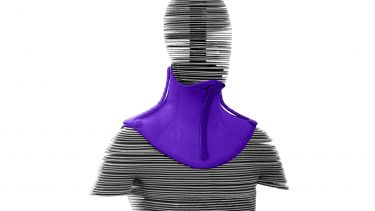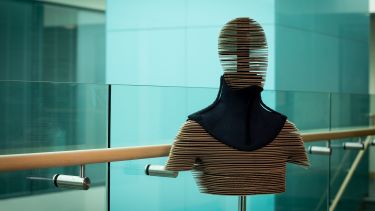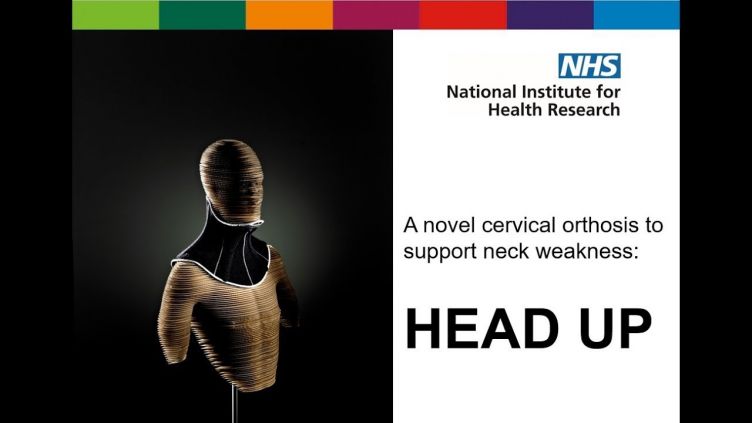The Head Up collar
Everyone values their independence. But motor neurone disease takes it from over 2,000 of us a year in the UK. Professor Chris McDermott and his team wanted to transform the lives of their patients by giving them some independence back.

In 2018, Phillip Brindle, raised his head and looked up. With the help of technology from The National Aeronautics and Space Administration (NASA) he’d finally been given his life back after years of staring at the floor. When he was diagnosed with motor neurone disease (MND) three years earlier, Phillip’s head had already begun dropping and the ground was becoming his only view.
Motor neurons directly and indirectly control our muscles and glands. When MND destroys these cells, it destroys our ability to run, walk, or simply look up from the ground. Within the first year of diagnosis it kills more than a third of those with the condition.
There’s a market full of solutions, various collars and neck braces that all claim to comfortably support the neck and head of MND sufferers, but many of these are often designed for sports injuries and car accidents rather than MND.
Professor Chris McDermott, a Professor of Translational Neurobiology at the University of Sheffield was approached by a patient who felt his needs weren’t being met by the collars available. The supportive collars were too hard to be comfortable and the comfortable collars were too soft to be supportive. So it fell to Chris and his team to develop the Goldilocks of MND collars - one that was just right.
“It seems so obvious when you think about it but working with the patients themselves to come up with the solution to their problems isn’t an approach that is often taken,” Chris explains. Chris and his team of interdisciplinary researchers from the University of Sheffield, Sheffield Hallam University, the National Institute for Health Research (NIHR) and the Motor Neurone Association took a patient-centred approach to developing a new collar.
It was through working with patients that Chris experienced a truly significant moment. In one of the patient-designer group meetings a patient articulated that she wanted the collar to allow her to turn her head from left to right. The designers listened to this, went away and a month later produced a new prototype that enabled that range of motion.
What was significant wasn’t that the designers did as the patient requested, it was the few seconds that followed; “That was the moment the patients realised that they were driving the process. I knew then that we were going to end up with something that was going to be helpful to patients,” Chris explains.
We’re making the journey from an idea to something useful to healthcare providers and patients around the world in collaboration with our patients. It’s a clear demonstration of the vision for the Neuroscience Institute at the University of Sheffield.
I like this idea that patients are involved in the design and supporting it in every iteration. The institute will allow us to follow the same pathway with the exciting neuroscience discoveries that we’re going to make. We can feed more things into the translational pathway by bringing together interdisciplinary talent and expertise.
Professor Chris McDermott
Professor of Translational Neurobiology
The patient-centred approach is one reason the collar is so successful. Another is the innovation that made it possible. It’s made from Outlast technology which is the same material used by NASA to line space suits. Chris highlights that the material used on previous products didn’t allow patients necks to ‘breathe’ easily – leading to sweaty, uncomfortable collars.
Outlast was developed in response to the extraordinary conditions and temperatures astronauts face – it absorbs, stores and releases energy as necessary to ensure an optimal neck temperature. The temperature regulation combined with customisable structural supports means the collar can be adapted to suit patients with a wide range of muscle loss severity.
The new collar, ‘Head up’, was as Chris expected – just right, and was celebrated in the MND community. More than 80% of patients reported they could eat, drink and read comfortably, knowing that their head and neck were fully supported.
Working closely with Talarmade Orthotics Ltd, a local Orthotics & prosthetics service in Chesterfield, thousands of units have been sold across Europe, including all of Scandinavia, Germany, Ireland, France, Spain, and the Netherlands.
The Head Up collar has been rolled out across the NHS and at least 25 trusts across the UK and around the world including Europe, The United States, Canada and Australia.
“The Head Up collar is an example of how we can take an idea, work on it, develop it in partnership, test it and then take it into the real world and give a real benefit to people,” says Chris
By working closely with patients and experts Chris and his team have produced the Head Up collar – something just right for improving patients’ quality of life and allowing them to continue living the life they want for longer.
And this is only one aspect of our work in improving the lives of patients with MND while we wait for disease-modifying therapies to come through.
Our dedicated researchers assess all aspects of MND. From how nutritional management could alleviate the caloric deficit suffered by many, to assessing psychological coping strategies and improving clinical services for patients. Professor Chris McDermott and his team at Sheffield Institute for Translational Neuroscience (SITraN) have also worked closely with people with MND, and their families, to design a website to help people make informed decisions about their treatment.
By Alicia Shephard
Further information
Relevant publications
Funders, awards and key grants
National Institute for Health Research (NIHR) i4i funding programme
Research profiles
Chris McDermott, Professor of Translational Neurology
Media coverage
Revolutionary neck support collar now available on the NHS for people with motor neurone disease
National Institute for Health Research
Innovative new collar to end MND patients' neck distress
Sheffield Teaching Hospitals NHS Foundation Trust
Revolutionary neck support technology transforms lives of MND patients
The University of Sheffield
For more information please contact:
Amy Pullan
Media Relations Officer
University of Sheffield
+44 114 222 9859
a.l.huxtable@sheffield.ac.uk


